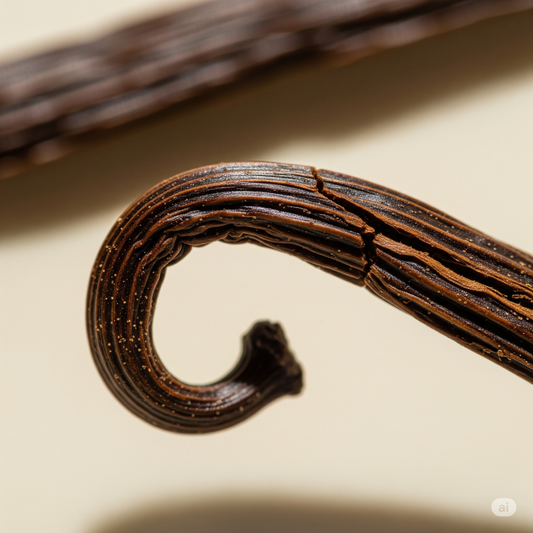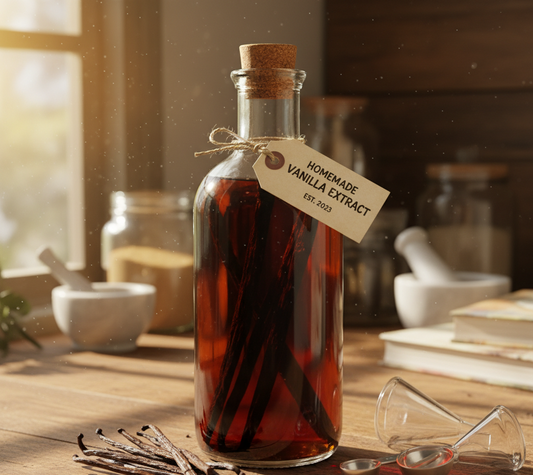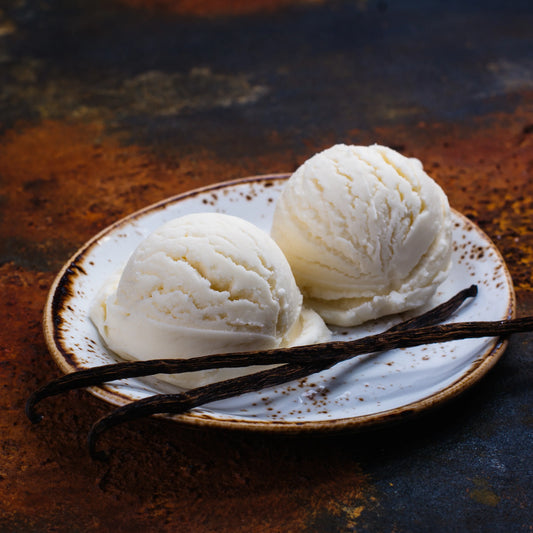
The Art of Vanilla Bean Harvesting: Timing and Technique
Share
Vanilla bean harvesting is an intricate process that requires careful timing and technique to yield the highest quality beans. At NY Vanilla, we source our premium vanilla beans directly from farmers in Uganda who have perfected the vanilla harvesting process.
When to Harvest Vanilla Beans
Vanilla beans take 9-10 months to fully mature after the vanilla orchid flowers are pollinated. The optimal time to harvest is when the beans have turned yellow or brown and feel oily to the touch. Premature harvesting leads to beans with poor flavor while overripe beans will split open.
Our farmers in Uganda have decades of experience determining the perfect moment to begin harvesting based on:
- Bean color change
- Aromatic vanilla scent
- Soft, pliable texture
They handpick only fully matured beans to ensure top quality and consistent flavor.

Harvesting Technique
Harvesting vanilla beans requires careful attention and skill. Here is an overview of the key steps our farmers use:
- Identify Mature Beans
Farmers walk through the orchards daily checking for beans that are ready for harvest. They look for beans that are:
- Yellow to brown in color
- Glossy and oily appearance
- Soft, pliable texture
- Intoxicating vanilla aroma
- Hand Pick the Beans
Once mature beans are identified, farmers hand pick each one gently to avoid splitting the bean open prematurely. Any beans with splits or blemishes are set aside. Only perfect, unblemished beans make it to the curing process.
- Sort Beans by Quality
After picking, the beans are sorted by quality and separated for processing. Our farmers classify the beans into:
- Grade A - Highest quality, perfect beans
- Grade B - Small splits or blemishes
- Grade C - Lower quality due to defects
This ensures only the very best beans get labeled and sold as our premium Grade A beans.
- Cure Beans Properly
Curing brings out the signature vanilla flavor and aroma. Our farmers use an months-long natural curing process to slowly dry and ferment the beans. Proper curing requires:
- Daily massaging and inspections
- Careful monitoring of temperature and humidity
- Allowing beans to fully mature through the curing process
This delicate process is essential for developing the complex flavor notes that make our vanilla so extraordinary.
The Key to Premium Vanilla
Producing premium quality vanilla beans comes down to two key factors - optimal timing of the harvest and meticulous harvesting techniques. Our farmers have perfected these methods over generations of cultivation. Their careful process is what allows us to source exceptionally flavored vanilla direct from the source for all our vanilla products.
Next time you enjoy velvety vanilla ice cream or a warm vanilla cake, remember the care and craftsmanship of farmers harvesting those flavorful beans by hand. Their impressive skills are worth savoring just as much as the exquisite vanilla taste itself.
The Origins of Vanilla Farming in Uganda
Vanilla farming has a long history in Uganda dating back to the early 20th century. Uganda's warm, tropical climate and rich volcanic soil provide ideal conditions for growing high quality vanilla.

The first vanilla vines were brought to Uganda in 1914 from Madagascar and Réunion Island by the British to cultivate on agricultural research stations. These early vines formed the genetic stock for the vanilla orchards across Uganda today.
By the 1930s, vanilla farming had expanded beyond research stations into private farms and plantations. Major production areas emerged in central and eastern regions like Mukono, Jinja, Mbale, and Busoga.
Vanilla's Heyday in Uganda
Uganda experienced a vanilla boom from the 1950s to 1970s and became one of the top vanilla exporters in the world. Smallholder farmers produced over 80% of the global supply of vanilla at this peak, with Uganda as a leading producer.
Several factors allowed Uganda's vanilla industry to thrive:
- Prime growing conditions - Uganda's tropical climate, ample rainfall, and fertile soils are ideal for vanilla orchards.
- Knowledgeable farmers - Experience cultivating vanilla was passed down through generations and farming practices refined over decades.
- High demand - Global demand for vanilla surged during this period, driven by rising popularity of ice cream and baked goods.
- Government support - Policies promoted vanilla and other cash crop exports with infrastructure development, loans, and market assistance.
During the height of production, vanilla accounted for over 20% of Uganda's total export revenue. It transformed rural economies and improved livelihoods for smallholder vanilla farmers.
Challenges in Recent Decades
While vanilla remains an important crop in Uganda, production faced significant challenges starting in the 1980s:
- Competition from other countries - Madagascar ramped up low-cost harvesting vanilla beans, undercutting Uganda's market share.
- Political instability - War and conflict in the 1970s-1990s disrupted farming and exports.
- Lack of cured bean exports - Uganda primarily exported raw, uncured beans with lower value added compared to finished cured beans.
- Low vanilla prices - Periods of oversupply led to crashing vanilla prices, discouraging farmers.
- Poor farming methods - Outdated cultivation practices and limited resources constrained yields for some smallholder farms.
Revitalization of Vanilla
In recent years, initiatives to modernize cultivation methods, increase quality, and connect farmers directly to buyers are supporting a resurgence of Ugandan vanilla.
Our company is proud to be part of this revitalization through our partnerships with smallholder vanilla farmers in Uganda. We provide:
- Training - Assisting farmers with techniques for improving orchards management and productivity.
- Materials - Distributing tools and supplies needed for harvesting and curing beans.
- Fair prices - Paying premium stable prices to farmers to sustain production.
- Direct sourcing - Purchasing beans directly from farmers so they receive more income.
This support empowers farmers to not only continue, but expand cultivation of high quality Ugandan vanilla for the world to enjoy.
How Size and Appearance Influence Quality
When searching for top quality vanilla beans, the size and appearance offer important visual clues on the flavor and aroma you can expect.

Bean Size
Longer, fatter vanilla beans tend to produce more seed pods which equates to higher vanillin content. Vanillin is the main compound that gives vanilla its distinctive flavor.
Larger, plump beans generally indicate:
- More vanilla flavor
- Higher vanillin content
- Greater aroma intensity
Smaller, thinner beans often have more subtle flavor notes.
Our premium vanilla beans are carefully hand selected for their large size and robust flavor.
Bean Appearance
The visual cues of color, sheen, suppleness and bean shapes provide clues on quality:
Color
- Dark brown - Fully mature, aged flavor
- Black - May be overripe with fading flavor
- Yellow - Still curing, underdeveloped aroma
Sheen
- Glossy - Well cured beans releasing oils
- Dull - Improperly cured, retaining moisture
Texture
- Supple - Optimal pliability, not dried out
- Brittle - Overly dry, less flexible
- Soft - Can indicate overripeness
Shape
- Straight - Properly handled during curing
- Curled - Improper drying techniques
Our farmers judge all these visual markers holistically to hand select only exceptional beans worthy of our NY Vanilla brand.
Enjoying Vanilla's Versatility in the Kitchen
Once you have sourced prime quality vanilla beans, the real delight comes in using their amazing flavor and aroma to enhance all types of foods and beverages.
Baking
Vanilla beans infuse baked goods with warmth and depth:
- Add whole beans or vanilla powder to cookie and cake batters
- Scrape seeds into frosting, custards, creams
- Infuse sugar or syrups by storing beans in the jar
Beverages
Vanilla accentuates coffee, tea, wine, spirits and more:
- Make vanilla simple syrup for cocktails
- Add beans to wine for infusion
- Simmer beans in milk for a cozy vanilla latte
Savory Dishes
A touch of vanilla brightens savory recipes:
- Toss beans into a steaming pot of rice
- Make vanilla bean butter for seafood
- Infuse vanilla into oil for sautéing veggies
DIY Vanilla Extract
One of the most rewarding uses is handcrafting your own vanilla extract.
- Split and scrape high quality beans
- Submerge in vodka or rum for a minimum of 3 months
- Shake periodically until the rich flavor is extracted
The options for using vanilla beans are only limited by your imagination. Our Ugandan vanilla will make any dish extra special.
Here is an additional 500 words continuing the article:
The Origins of Vanilla Farming
Vanilla has a long and storied history as one of the world's most prized spices. It all started with the Totonac people in what is now Mexico. As early as the 1400s, the Totonacs were the first to cultivate vanilla orchids and learn how to properly pollinate, harvest, and cure the beans.
The labor-intensive process made natural vanilla extremely rare and expensive. It was considered a luxury item accessible only to Aztec royalty and the upper classes. When the Spanish conquered the Aztec empire in the early 1500s, they discovered vanilla and brought it back to Europe where its popularity exploded.
By the 1800s, French entrepreneurs finally unlocked the secrets of hand pollination and vanilla farming began spreading to tropical regions around the world. Madagascar and Réunion Island became major early producers. In the late 1800s, vanilla made its way from Réunion to the British-controlled Seychelles islands off the coast of Africa. Around the same time, it was introduced to Uganda by British and German colonists.
Vanilla Cultivation Spreads Through Africa
The climate and soil conditions in many parts of Africa proved excellent for growing vanilla. Production took off in Uganda, Kenya, Tanzania and Madagascar during the early 1900s. Vanilla became an important cash crop that provided livelihoods for small family farms.
Methods for cultivation, harvesting and curing evolved over decades to maximize quality. Farmers learned the nuances of when to harvest based on regional climate patterns. Local curing techniques were perfected that became community knowledge passed through generations.
Africa remains a major source of premium vanilla today. Countries like Uganda nurture the cultivation process from orchid propagation through harvest and curing. Our relationships with experienced vanilla farmers in Uganda allows us to source exceptional beans and share their remarkable vanilla with customers around the world.
The Process of Growing Vanilla Orchids
The journey from vanilla orchid flower to cured bean is fascinating...and remarkably intricate. It begins with caring for vanilla vine orchids that can grow up to 300 feet long in tropical climates. The vines take 3-4 years to mature enough to produce flowers. When grown under optimal natural conditions, the vines will flower each spring.
Pollination
The orchid flowers must be hand pollinated within 12 hours of blooming. In nature, this is done by Melipona bees that are native to Mexico. But outside of Mexico, human hand pollination is required.
Farmers use a small bamboo stick or toothpick to transfer pollen from the male anther to the female stigma by gently lifting the flap-like rostellum between them. Each flower must be pollinated individually by hand. It is extremely meticulous work.
Fruit Development
Once pollinated, the flowers develop into long green fruits that hang off the vines. It takes 9-10 months for the fruits to fully mature into the beans we know as vanilla. The beans actually are the cured fruit, not a seed or nut.
Flavor Formation
As the beans ripen, complex flavor and aromatic compounds develop including vanillin, acids, and esters. The signature vanilla flavors emerge only in fully mature beans. Picking them too early results in poor, weak vanilla. Patiently waiting for each bean to ripen guarantees rich, nuanced flavor.
Curing: Transforming Beans into Vanilla
Curing freshly picked green vanilla beans is the final critical step in developing their depth of flavor. Our farmers use a natural curing process that takes 4-6 months.
It involves two main phases:
- Drying- Beans are laid out daily and exposed to indirect sunlight to reduce moisture content. They are massaged and inspected for even drying.
- Conditioning- The drying beans are "sweated" for weeks wrapped in blankets to provoke chemical reactions that produce the signature vanilla notes.
It takes steady vigilance, routine massaging, and monitoring temperature and humidity daily for months on end. But this careful natural curing is what truly transforms fresh green beans into the dark, supple cured vanilla with intricate flavors and irresistible aroma.
Continuing an Ancient Tradition
Vanilla has come a long way from its origins in Mexico centuries ago. Today it is beloved around the world as a quintessential baking ingredient and flavoring.
The hands-on process of cultivating orchids, pollinating flowers, picking ripe beans, and slowly curing each bean remains largely unchanged from ancient times. Families in tropical regions like Uganda continue these time-honored traditions and techniques passed down through generations. Their dedication and skill are what allow us to enjoy exceptional quality vanilla.




1 comment
What time of year are the Mexican Vanilla Beans available to buy from you, and would you e-mail me when that time comes, please?